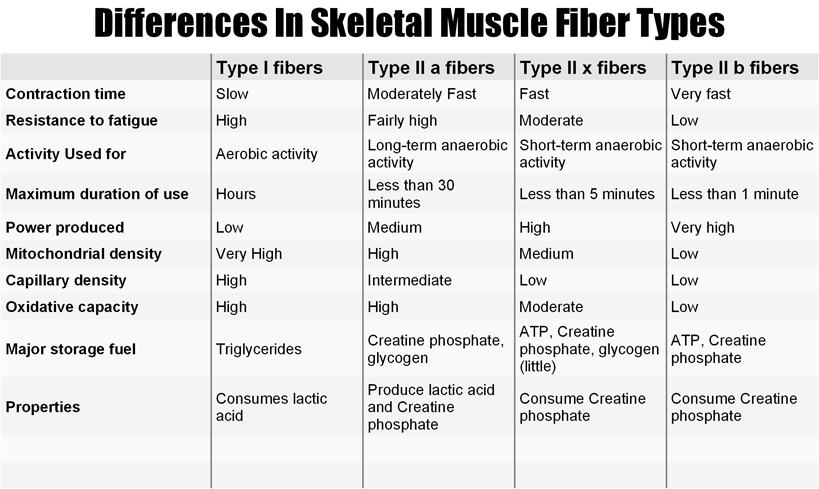

There are four different types of muscle fibers:
 Type I
Type I
Type I muscle fibers are also called slow twitch red muscle fibers.
They are red due to all of the blood that goes through them due to their high level of capillarization. These fibers are rugged in nature (they are not easily injured), can handle extreme amounts of work and do not fatigue easily.
They require oxygen as fuel and because of this, they are the ones most used in endurance type of sports like marathon running, cycling and cross-country.
Type IIA
Type IIA fibers are fast twitch white muscle fibers.
These fibers have much less blood flow in them as others, they have a moderate tolerance to fatigue and can handle moderate amounts of work.
They require glycogen as fuel and they are involved in most types of activities such as Karate, basketball, baseball and football.
Type IIB
Type IIB fibers are also fast twitch white muscle fibers but these fibers have a very low tolerance to fatigue and need a high period of recovery after use.
However, they are extremely powerful and explosive fibers and are the ones involved in activities like Karate, power lifting, the pitch of a baseball, javelin-throwing, shot-putting, the beginning of a sprint, etc.
In other words, anything that has a short burst explosive nature. Because of this, they use ATP/CP as fuel
Type IIC
Type IIC fibers are “freak type” fibers.
They are formed when satellite cells chemically bind with the Type IIB fibers. When such an event happens, this event is called hypertrophy.
So by now you have probably guessed these fibers are more predominant in bodybuilders.
(Note: Satellite cells are cells that abound in muscle tissue but have no contractile ability.
Scientists are not sure about their function but they add bulk and structural support to the muscle).
Average Distribution
On the average, most people have a distribution of 50% Type IIA fibers, 25% Type IIB and 25% Type IIC.
The body has the capability to change these ratios based on the stimulus imposed.
Nervous System’s Ability to Change Fiber Types Believe it or not, recent research indicates that the nervous system has the ability to change fiber types over time, based on the nature of the imposed stimulus.
If the stimulus imposed is of an endurance nature, then the nervous system will change most fiber types to become Type I endurance fibers.
If the stimulus is a bodybuilding type of stimulus, then the body will go ahead and start turning its II B fibers into II C fibers.
Therefore, this dispels the myth you need good genetics to get big muscles. As long as you have the right training program, your body will adapt.